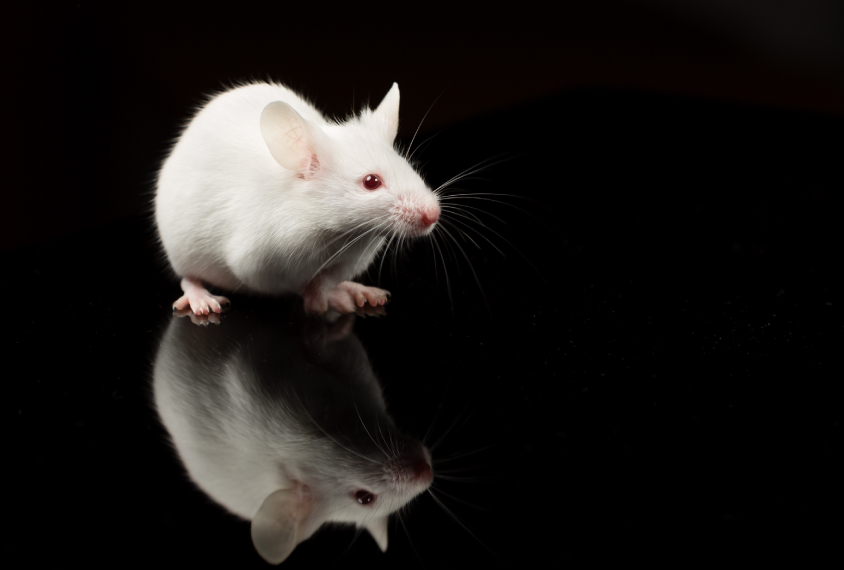
‘Fragile’ behaviors mar studies of popular autism mouse model
Researchers should proceed with caution when studying the behavior of one of the most popular mouse models of autism: the fragile X mouse model.
Researchers should proceed with caution when studying the behavior of one of the most popular mouse models of autism: the fragile X mouse model. That’s the upshot of five years’ worth of data collected from two of the mouse strains.
Researchers presented the findings yesterday at the 2017 Society for Neuroscience annual meeting in Washington, D.C.
The data show that the mice lack many of the autism-related behaviors seen in previous studies of the model, such as social difficulties and repetitive behaviors. Other behavioral deficits, such as movement problems, appear or disappear depending on the conditions of the test.
“It’s important for the field to know,” says lead investigator Jennifer Tudor, assistant professor of biology at Saint Joseph’s University in Philadelphia. “The behavioral phenotype is so subtle it just makes it a very, very hard mouse to work with.”
Although this conclusion surprises few autism mouse aficionados, it is only now being acknowledged openly.
“It is refreshing to see these data presented,” says Jill Silverman, assistant professor of psychiatry and behavioral sciences at the University of California, Davis. Silverman says she found similar results in a third strain of the mouse, and that she’s heard through the grapevine about other inconsistencies in the model.
The mice in question carry a mutation in the FMR1 gene, and produce none of its protein, FMRP. Loss of this protein leads to fragile X syndrome, one of the most common genetic causes of autism and intellectual disability.
Numerous studies of mice missing FMR1 suggest that the animals have several autism-like features. For example, they do not show the usual preference for interacting with an unfamiliar mouse over a familiar one. They have trouble learning the location of a hidden platform in a water tank. They repetitively bury marbles in their bedding and are more active than controls.
These behaviors are akin to the social problems, cognitive difficulties, repetitive behaviors and hyperactivity seen in people with fragile X syndrome.
‘It’s just not there:’
The mice are routinely used to test new potential therapies for the condition. At least four papers reporting tests of new treatments in fragile X mice have been published in the past four months.
Tudor and her colleagues wanted to test the animals’ response to the diabetes drug metformin, which has been shown to reverse fragile X-related problems in fruit flies. So they purchased a strain of mice missing FMR1 from the Jackson Laboratory, a mouse supplier. Their first goal was to characterize the behaviors of the mice so they could determine whether treating them with metformin has any effects.
They confirmed that FMRP is absent in brain samples from the mice. They also confirmed that the mice are slightly heavier than normal and that males have enlarged testes. So far, so good. “We have the physical phenotypes that we would anticipate with our FMR1 mice,” Tudor says.
They then put the animals in a cage that automatically detects movements using radio waves and microchips implanted in the skin. To Tudor’s surprise, the mutant mice were only slightly more active than controls during the day. At night, when mice are usually most active, the mutant animals were less active than controls.
Next, the researchers put the animals through a battery of behavioral tests. Unexpectedly, the mutant mice behave no differently than controls do when approaching an unfamiliar mouse, burying marbles, or learning how to escape from a water maze.
Thinking that there might be something wrong with her mutant mouse strain, Tudor purchased a different strain from the Jackson Laboratory. But when she tested the behaviors of the new strain, she got similar results: They were no different from controls.
“It’s not an issue of the acuity or the resolution of the tasks that we weren’t able to see it,” Tudor says. “It’s just not there.”
Vanishing variation:
Tudor was somewhat relieved when she saw coordination problems in the first mutant mouse strain: The animals learn to balance on a rotating rod, but fall off sooner than controls do. However, when she increased the interval between trials of the task, the differences disappeared. And when she tested the other mutant strain, they performed just as well as controls.
“We think the deficit is there,” Tudor says — at least, in one strain of the mice. “However, it’s super variable. If we change up the task a little bit, the differences are obliterated.”
Tudor says it’s unclear why she and others are having trouble reproducing canonical behaviors of the mutant mice. One possibility is that the genomes of the various strains have deviated slightly from the original mice in ways that affect their behavior. Another possibility is that the behaviors researchers attribute to autism are instead due to the seizures that some FMR1 mutant strains have. Tudor says she did not see any seizures in her mice, but they may occur in other mice and alter their behavior.
Either way, Tudor and others say it’s time to confront the elephant in the room. “If the behavioral phenotype is not strong and consistent and reliable across cohorts, we can’t continue to pursue it for drug studies, in my opinion,” Silverman says.
But if researchers proceed with the studies anyway, Tudor says they should test their candidate treatments in at least two different strains of the mouse.
For more reports from the 2017 Society for Neuroscience annual meeting, please click here.
Recommended reading

New organoid atlas unveils four neurodevelopmental signatures

Glutamate receptors, mRNA transcripts and SYNGAP1; and more

Among brain changes studied in autism, spotlight shifts to subcortex
Explore more from The Transmitter
Can neuroscientists decode memories solely from a map of synaptic connections?

AI-assisted coding: 10 simple rules to maintain scientific rigor
